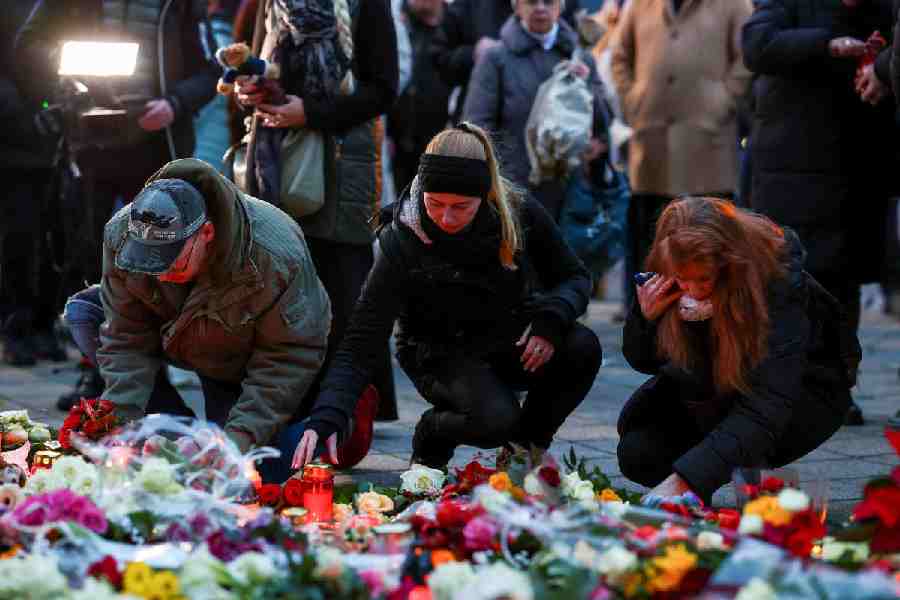 Monday, 23 December 2024
Monday, 23 December 2024
 Monday, 23 December 2024
Monday, 23 December 2024
You might be excited about Election Day, dreading it, or desperate for it to be over.
Regardless, it is here.
But the end of this high-drama presidential campaign on election night may not bring immediate clarity about who has won.
The race itself is unlike any other, pitting former President Donald Trump, a man who has essentially been running for president for nine years, against Vice President Kamala Harris, a woman who has been running for about 16 weeks. The contest, which began as a rare rematch between Trump and President Joe Biden, was reset after a televised debate that ended Biden’s bid for reelection and paved the way for Harris’ midsummer ascendance — and it took a violent turn when two would-be assassins made separate attempts on Trump’s life.
More than 78 million people have already voted. And as we head into the final day of voting, polling suggests that two candidates who could not be more different — who fundamentally disagree on weighty matters of the economy, women’s rights and the very purpose of government — are locked in an excruciatingly tight contest, with all seven battleground states still in play.
It could take days or even longer to know who wins. Here’s what to watch as the counting begins.
When will the race actually end?
Polling shows Harris and Trump deadlocked in nearly all seven swing states. So the first thing we’ll glean from the returns Tuesday night is not who will win — but just how close the battle is shaping up to be, and how long it might take to determine the winner.
The first battleground state where the polls will close is Georgia, at 7 p.m. Eastern time, followed closely by North Carolina, at 7:30 p.m. Eastern. A majority of voters cast ballots early in both states, and those results are expected to be reported early in the night. The vast majority of ballots in both states are likely to be tallied and reported by midnight. They will give us an early sense of whether the night is shaping up to be a battle of inches, or something more decisive.
If Harris opens up a lead in either or both states, she will have multiple paths to the 270 electoral votes needed to win, and Trump’s chances of victory will appear to narrow. If Trump has a lead, or if the states appear to be close, it could all come down to the returns from the three so-called Blue Wall states of Pennsylvania, Michigan and Wisconsin.
In Pennsylvania, which both campaigns view as a must-win state, polls close at 8 p.m. Eastern time. But because election workers aren’t allowed to start processing mail ballots until Election Day, counting is expected to stretch past Tuesday night. In Michigan, where the last polls close at 9 p.m. Eastern, only about half the ballots were counted by midnight in 2020 and 2022, although recent reforms could speed things up. In Wisconsin, where polls close at 9 p.m. Eastern, counting could stretch late into the night.
Trump’s best path to the presidency has long been seen as victories in Pennsylvania, Georgia and North Carolina. Harris’ best path is seen as Pennsylvania, Michigan and Wisconsin. If the picture is muddled, we could find ourselves looking west for answers — and that could mean a long wait.
The polls in the two Western swing states, Arizona and Nevada, close at 9 p.m. and 10 p.m. Eastern, respectively. But both states rely heavily on mail ballots, and the counting could stretch for days.
In recent elections, all the Blue Wall states have typically voted the same way, but it’s not clear that pattern will hold this year.
The battleground states aren’t the only place to look for hints about which way the night is going. There are a few congressional races in faster-counting East Coast states, including the 2nd and 7th Districts of Virginia and the 1st District in North Carolina, where an upset could be a sign of bigger success for whichever party prevails.
Our best advice for Tuesday night, and maybe the days beyond, is to remain patient.
A system under pressure.
In 2020, Trump falsely declared victory just after 2 a.m. on election night, sowing doubt among his supporters about Biden’s eventual victory and the elections system itself — and stoking a movement that eventually culminated in the attack on the Capitol on Jan. 6, 2021.
In recent weeks, Trump has reached into that the same playbook, inaccurately claiming that voting machines can change people’s votes and wrongly suggesting that the only way Harris can win is if she cheats.
Another premature declaration of victory could raise the likelihood of postelection discord and create additional strain on a system already bearing the weight of election denial, as pro-Trump activists spread unfounded claims of fraud. Lawyers on both sides are poised to litigate these matters until the bitter end.
Whose gambles paid off?
Both parties took enormous risks this year. Republicans nominated Trump, an unpopular political figure who lost his last campaign. They put the pursuit of young, male and nonwhite voters who don’t always make it to the polls at the heart of their strategy. And they outsourced much of their ground game to groups with little experience.
Democrats, for their part, nominated the oldest candidate in history in Biden. When he dropped out under pressure, they threw their support to Harris and pursued an unusual tactic of their own: outreach to Republicans.
The election results will tell a story about what worked and what did not.
How big will the gender gap be?
Harris, who would be the nation’s first female president, almost never talked about her gender in the campaign. But, for months, polling has suggested a stark gender divide.
Democrats framed the campaign, the first presidential contest since the Supreme Court overturned the constitutional right to abortion, as a battle over women’s freedoms and place in society, and they encouraged women to vote for Harris even if the men in their lives were supporting Trump — and even if that meant keeping their vote secret. Trump reached out to men with crude and bombastic appeals to exaggerated masculinity. And the campaign was infused with questions about the degree to which sexism might hurt Harris.
Exit polling will give us an early sense of just how large the matter of gender really loomed.
Does the abortion rights movement maintain its momentum?
Since the Dobbs decision overturned the constitutional right to an abortion in 2022, supporters of abortion rights have enjoyed an series of victories as they have sought to protect those rights on the state level. On Tuesday, voters in 10 more states will decide whether to enshrine abortion rights into their constitutions.
Referendums in red states including Florida, Montana, South Dakota and Missouri will test whether abortion rights have essentially transcended partisanship, since they will almost certainly require Republican support to pass. But in purple states, they will also test the limits of abortion as a motivating factor for other Democratic candidates. In Arizona and Nevada, polling suggests some voters may back abortion rights and also vote for Trump for president.
Republicans could close in on a Senate majority, but it’s not a done deal.
Control of the House and Senate is on the line, but it may take some time before we know how it will shake out.
Control of the Senate has long seemed like Republicans’ to lose, but we may not know for sure until later in the night. Republicans are practically guaranteed to pick up a seat in West Virginia, where the polls close at 7:30 p.m. Eastern time. In Montana, where the polls close at 10 p.m. Eastern, Sen. Jon Tester, a Democrat, has been trailing his Republican challenger. That race might determine the balance of power in the Senate.
To get a sense of how deep the Democratic losses could go, keep an eye on Ohio, where the polls close at 7:30 p.m. Eastern and most of the vote should be counted on election night. A strong performance by Sen. Sherrod Brown would be a good sign for Democrats; an upset could be a harbinger of more trouble for Democrats in slower-counting states where incumbents face tough races, including in Wisconsin and Pennsylvania.
But there are also two states where Republicans are unexpectedly on defense. In Nebraska, Sen. Deb Fischer is facing a surprisingly tough challenge from independent labor activist Dan Osborn. And in Texas, where most vote counting is expected to be done on election night, polling shows the Democratic challenger, Colin Allred, in striking distance of Sen. Ted Cruz.
Determining control of the House could take days — or weeks.
The battle for the House majority is shaping up to be one of the tightest contests in recent memory. The path to victory is widely seen as running through competitive districts in New York and California, where Democrats are facing dissatisfaction from centrist voters. California, in particular, will take time to sort out: Polls there close at 11 p.m. Eastern, and the state relies heavily on mail ballots, which can take weeks to count.
There are several districts to watch to get a sense of the way things might be headed. New York’s 22nd District, in the Syracuse area, is widely seen as likely to flip from red to blue, so strength by Rep. Brandon Williams would be a good sign for Republicans. In the Hudson Valley, a strong showing by Democrat Mondaire Jones against Rep. Mike Lawler, a Republican, could be a sign that Democrats were on track to reclaim the House.
Keep an eye, also, on a pair of competitive districts in Iowa, where Democrats are hoping that backlash to the state’s restrictive abortion law will help them unseat two Republicans. There are also several competitive districts in Pennsylvania, including a stiff challenge faced by Rep. Scott Perry, an election-denying ally of Trump, that could play a role in determining the chamber’s balance of power.
Is ticket-splitting a thing?
For much of the year, polls showed something intriguing: Republican Senate candidates in many competitive states were running behind Trump, while Democratic Senate candidates were running ahead of Biden — and then, later, Harris. Tuesday’s results will tell us whether a polarized country still has room for voters who choose divided government.
Ticket-splitters are the last hope for Tester in Montana; he would probably need to outrun Harris by double digits to win. And they could prove determinative in a state like Arizona, where the Rep. Ruben Gallego, a Democrat, has consistently led the Trump-aligned Kari Lake in the Senate race even as the presidential contest in the state seems to show a slight Republican edge.
Are there signs of a bigger voter realignment?
All year, polling has suggested that several key groups of voters are getting a little less Democratic, with Trump making inroads with Black, Latino and young voters while Democrats’ long-standing advantage in cities erodes. Democrats, by contrast, have improved their standing with white voters and older voters who used to be more likely to vote Republican.
It will be a long time before we can say with certainty whether 2024 brought a broader realignment — and years before we know if any shift was permanent. But exit polling, as well as Democratic performance in congressional districts with a lot of these voters, including in the Rio Grande Valley in South Texas or in rural districts with lots of Black voters like North Carolina’s 1st District, will offer some early hints.
The New York Times Services







